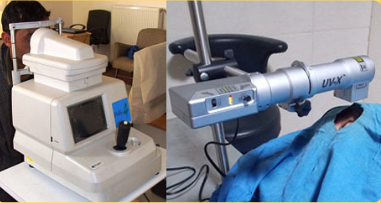The surface of the eye bulges out in a cone shape. This is called Keratoconus. This happens when the front layer of the eye (the cornea) starts to thin. At first, the bulge may be mild but the condition can get worse over time. It normally affects both eyes.
(PLEASE CLICK HERE FOR IMAGE FORMAT :KERATOCONUS)
(PLEASE CLICK HERE FOR TAMIL IMAGE FORMAT: KERATOCONUS )
Causes:
The cause of keratoconus is not known.


• Family history of keratoconus
• Rubbing your eyes.
• A type of allergy (VKH).
• Conditions like retinitis pigmentosa, Down syndrome, hay fever and asthma.
Symptoms:
• Glare
• Blurry vision
• Sensitivity to light
• Frequent changes in spectacle power.
• Sudden cloudy vision.
• In the early stages, vision can be corrected with spectacles.
• In later stages, an individually-fitted hard contact lens must be used. This lens gives better vision. However, it can also increase your sensitivity to light and glare. Finding a comfortable lens can be difficult, but it is important that the lens fit well. Poorly fitting lenses can damage the cornea even more.
• If you cannot wear contact lenses or have corneal scarring, your doctor may suggest a corneal transplant.
• Another option is corneal cross-linking (also called C3-R). This treatment is new and non-invasive. It works by increasing the strength of the cornea.This may not fix the existing bulge, but it can stop it from getting worse.
contact lens for keratoconus:

Keratoconus (keh-rah-toe-cone-us) is a non-inflammatory eye disorder in which the round dome-shaped cornea progressively thins causing a cone-like bulge to develop.Hence the name keratoconus, from the Greek word ‘kerato’ (cornea) and ‘conus’ (cone-shaped).
Because those with keratoconus have irregular, cone-shaped corneas, glasses cannot conform to the shape of the eyes and thus cannot adequately correct the patients’ vision. The best solution, therefore, is scleral contact lenses, since they sit on the sclera without touching the cornea and deliver maximal clarity while being perfectly comfortable in most cases.
Scleral contact lenses are the gold standard when it comes to choosing contact lenses for keratoconus because they provide both clear vision and superior comfort. Scleral lenses are designed with a “dome” or reservoir that floats above the eye's surface. This shape serves multiple purposes.
corneal cross linking (C3 - R) :
Until recently, there was no method to change the integrity and strength of the cornea itself for keratoconus patients. The noninvasive treatment c3-R *(Corneal collagen cross-linking riboflavin) treatment has been proven to strengthen the weak corneal structure in keratoconus. This method works by increasing collagen cross-linking, which are the natural "anchors" within the cornea. These anchors are responsible for preventing the cornea from bulging out and becoming steep and irregular (which is the cause of keratoconus).
Intra Corneal Ring Segments:
Intra Corneal Ring Segments (ICRS) are specialized and customized arc like segments which are inserted into the cornea using a sophisticated femtosecond laser. These segments improve vision by converting a conical cornea into a more natural spherical shape.
Laser- Topography Guided Treatment:
This is a specialized laser based treatment which greatly enhances vision in patients with moderate Keratoconus by smoothening the weakened protruding conical part of the cornea. This topography guided treatment in combination with cross linking has become the procedure of choice for improving vision when Keratoconus is diagnosed early.
Implantable Contact Lenses:
Toric Implantable Contact Lens(TICL) is capable of providing good correction in cases of stable Keratoconus or after stabilization of the cornea by collagen cross linkage(C3R). The difference is that the lens is placed inside your eye, rather than on the surface.
KERATOPLASTY FOR KERATOCONUS :
Penetrating keratoplasty is a safe and effective procedure with remarkable optical and visual outcomes for patients with keratoconus who are contact lens intolerant or have unacceptable corrected visual acuity.
.jpg)
.jpg)















.jpg)
Comments